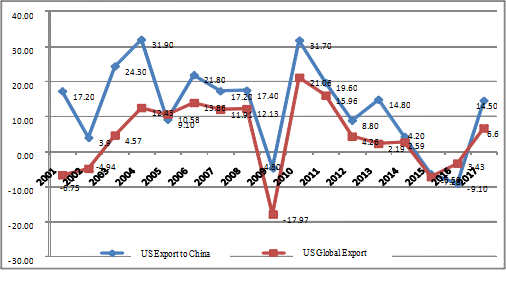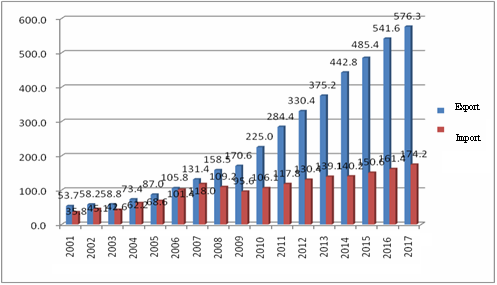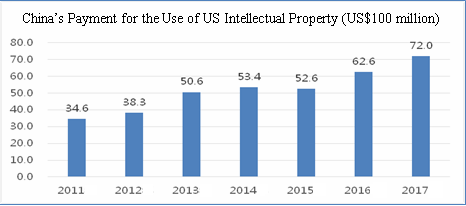I. Mutually-beneficial and win-win cooperation between China and the US in trade and economy
Economic and trade relations have developed steadily since the establishment of diplomatic ties between China and the US, with fruitful results achieved in trade and investment. China benefits remarkably from the strong synergy, while the US also reaps extensive economic benefits from the opportunities and results generated by China's growth. It is self-evident that a sound China-US economic and trade relationship is very important for both countries. Cooperation serves the interests of the two sides and conflict can only hurt both.
1. China and the US are important partners for each other in trade in goods.
Two-way trade in goods has grown rapidly. Chinese statistics show that trade in goods between China and the US in 2017 amounted to US$583.7 billion, a 233-fold increase from 1979 when the two countries forged diplomatic ties, as well as a seven-fold increase from 2001 when China joined the World Trade Organization. Currently, the US is China's biggest export market and sixth biggest source of imports. In 2017, the US took 19% of China's exports and provided 8% of China's imports. China is the fastest growing export market for US goods and the biggest source of imports of the United States. In 2017, 8% of US exports went to China.
US exports to China are growing much faster than its global average. Since its accession to the WTO, China has become an important market for US exports, which have grown rapidly. UN statistics indicate that in 2017 US exports of goods to China amounted to US$129.89 billion, a 577% increase from US$19.18 billion in 2001, and far higher than the 112% average growth rate of overall US exports (Chart 1).1
Chart 1: US Exports to China Grow Faster than its Global Export Trade (%)

Source: UNCTAD
China is an import market for US goods such as airplanes, agricultural produce, automobiles, and integrated circuits. China represents the No. 1 export market for US airplanes and soybeans, and the No. 2 export market for US automobiles, IC products and cotton. In 2017 China took 57% of US soybean exports, 25% of Boeing aircraft, 20% of automobiles, 14% of ICs and 17% of cotton.
China-US bilateral trade has a strong complementarity. The US stands at the mid-and high-end in global value chains and it exports capital goods and intermediary goods to China. Remaining at the mid-and low-end in global value chains, China mainly exports consumer goods and finished products to the US. The two countries play to their comparative strengths and the two-way trade is highly complementary. In 2017, the top three categories of Chinese exports to the US were:
1. electric machines/electrical products/equipment and components,
2. mechanical apparatus and components, and
3. furniture/bedding/lamps,
which accounted for 53.5% of its total exports to the US. The top three categories of products that China imported from the US were:
1. machinery/electric equipment/ components and accessories,
2. mechanical apparatus and components, and
3. automobile and components and accessories,
which accounted for 31.8% of total import from the US. Machinery and electronic products take a lion's share of two-way trade, and there is an evident characteristic of intra-industry trade. (Table 1) For most of the hi-tech products that China exports to the US, only labor-intensive processing takes place in China, involving large-scale import of key components and intermediary products as well as international transfer of value.
Table 1: Major China's imports from and exports to the US (HS 2-digit)
Imports | Share in imports from the US (%) | Exports | Share in exports to the US (%) |
Chapter 85 electric motor, electric products, audio-visual equipment and components and accessories | 11.3 | Chapter 85 electric motor, electric products, audio-visual equipment and components and accessories | 24.9 |
Chapter 84 nuclear reactors, furnaces, mechanical apparatus and components | 10.7 | Chapter 84 nuclear reactor, furnace, mechanical apparatus and components | 21.3 |
Chapter 87 automobiles and components and accessories, excluding railway cars | 9.8 | Chapter 94 furniture, bedding, lamps and trailer coach | 6.8 |
Chapter 12 oilseeds, kernels, plants for industrial or pharmaceutical purposes, animal feed | 9.5 | Chapter 95 toys, game or sport articles and components and accessories | 4.3 |
Chapter 88 aircraft, spacecraft and components | 9.2 | Chapter 61 knitwear, crocheted apparel and accessories | 3.7 |
Chapter 90 optical, photographic and medical devices and components and accessories | 7.6 | Chapter 39 plastics and plastic articles | 3.6 |
Chapter27 mineral fuels, mineral oil and products, asphalt, etc. | 4.7 | Chapter 87 automobiles and components and accessories, excluding railway cars | 3.5 |
Chapter 39 plastics and plastic articles | 4.5 | Chapter 62 non-knit wear, non-crocheted apparels and accessories | 3.3 |
Source: China Customs
2. Bilateral trade in services is developing quickly.
The US has a highly-advanced and fully-fledged service industry which is very competitive on the international market. Accompanying the growth of the Chinese economy and the improvement of Chinese people's living standards is an obvious rise in demand for services and rapid growth in bilateral services trade. According to US statistics, two-way trade in services rose from US$24.94 billion in 2007 to US$75.05 billion in 2017. According to MOFCOM, the US was China's second biggest services trade partner; according to USDOC, China is the third biggest market for US service exports.
The US is the biggest source of China's deficit in services trade and this deficit has been increasing fast. US statistics show that US service exports to China grew 340% from US$13.14 billion in 2007 to US$57.63 billion in 2017 while its service exports to other countries and regions in the same period grew by 180%. The US surplus with China in services multiplied by a factor of 30 to US 40.2 billion. (Chart 2) At present, the US represents roughly 20% of China's total deficit in services trade, the biggest source of this deficit. China's deficit with the US is concentrated in three areas, travel, transport and intellectual property royalties.
Chart 2: US Services Imports from and Exports to China (unit: US$100 mn)

Source: Bureau of Economic Analysis, US DOC
China's trade deficit with the US in tourism continues to widen. According to the DOC, by 2016 the number of Chinese mainland visitors to the US had been increasing for 13 consecutive years, with double-digit growth in 12 of the 13 years. MOFCOM statistics suggest that in 2017 Chinese visitors going to the US for tourism, education, and medical treatment spent a total of US$51 billion in the US. Among them, 3 million were tourists, who spent as much as US$33 billion while traveling in the US. In education, the US is the largest overseas destination for Chinese students. In 2017, there were around 420,000 Chinese students in the US, contributing some US$18 billion to local revenues. According to US figures, China's trade deficit with the US in tourism grew from US$430 million in 2006 to US$26.2 billion in 2016, registering an average annual growth of 50.8%.
China's payments for the use of US intellectual property continues to rise. Chinese statistics indicate that the US is the largest source of intellectual property imports to China. From 2012 to 2016, China imported nearly 28,000 items of intellectual property from the US. China's payments for US intellectual property doubled in six years from US$3.46 billion in 2011 to US$7.2 billion in 2017. (Chart 3) In breakdown, China's intellectual property payments to the US accounted for a quarter of its total intellectual property payments to foreign countries.
Chart 3: China's Payment for the Use of US Intellectual Property

Source: MOFCOM, China
3. China and the US are important investment partners.
The US is a major source of foreign investment for China. According to MOFCOM, by the end of 2017, there were approximately 68,000 US-funded enterprises in China with over US$83 billion in actualized investment. With a rapid increase in direct investment by Chinese enterprises in the US, the latter has become an important destination for Chinese investment. As China's outbound investment grew, Chinese enterprises' direct investment in the US rose from US$65 million in 2003 to US$16.98 billion in 2016. According to MOFCOM figures, by the end 2017, the stock of Chinese direct investment in the US amounted to approximately US$67 billion. Meanwhile, China has also made a significant financial investment in the US. According to the US Treasury Department, China held US$1.18 trillion of US treasury bills by the end of May 2018.
4. China and the US have both benefited markedly from trade and economic cooperation.
China and the US have both reaped enormous benefits and created win-win results from trade and economic cooperation.
China-US trade and economic cooperation has promoted economic development in China and improved economic wellbeing. Against the backdrop of economic globalization, strengthening trade and investment cooperation with other countries, including the US, and opening up markets to each other has helped Chinese enterprises integrate into the global industrial chain and value chain, and opened up a huge external market for Chinese economic growth. Thanks to economic development over the past 40 years of reform and opening up, in 2017 China became the world's largest trader in goods, with US$4.1 trillion of total merchandise imports and exports. It became the second largest trader in services with US$695.68 billion worth of total services imports and exports. And it became the second largest recipient of FDI, with US$136 billion of inward foreign investment. American firms have played an exemplary role in China for their Chinese peers in terms of technological innovation, marketing management, and institutional innovation. They have promoted market competition, improved industry efficiency, and motivated Chinese firms to improve their technology and management. In importing a large number of mechanical and electrical products and agricultural products from the US, China has managed to make up for its own supply deficiencies, and satisfy the demand—especially high-end demand—in various sectors by offering consumers a diversity of choice.
At the same time, the US has gained access to a wide range of business opportunities such as cross-border investment and entry into the China market, which have played a big part in driving economic growth, improving consumer welfare, and upgrading the economic structure in the US.
Trade and economic cooperation has supported US economic growth and lowered US inflation. A joint estimate by the US-China Business Council and Oxford Economics2 indicated that in 2015 imports from China drove up the US gross domestic product by 0.8 percentage points. Exports to China and two-way investment contributed US$216 billion to America's GDP, pushing US economic growth rate up by 1.2 percentage points. Value-for-money products from China drove down prices for American consumers, and in 2015 for example, reduced the consumer price index by 1 to 1.5 percentage points. A low inflation environment has created much room for expansionary macroeconomic policies in the US.
Trade and economic cooperation has created a large number of jobs in the US. According to a US-China Business Council estimate, in 2015, US exports to China and US-China two-way investment supported 2.6 million jobs in America.3 Specifically, Chinese investment covered 46 states of the US, generating for the US more than 140,000 jobs, most of which are in manufacturing.
Trade and economic cooperation has brought real benefits to American consumers. Bilateral trade provides consumers with a broad range of choices, lowers their living costs, and raises the real purchasing power of the American people, especially the low- and middle-income cohort. According to the US-China Business Council, in 2015, trade with China saved every American family US$850 of expenditure each year, which is equivalent to 1.5% of the average household income in the US.4
Trade and economic cooperation has created a large number of business opportunities and significant profits for American businesses. With China being a huge and rapidly growing market, trade and economic cooperation between China and the US has created huge business opportunities for American businesses. From the trade perspective, the US-China Business Council 2017 State Export Reportfound that in 2017, China was one of the top five export markets of goods for 46 states. In 2016 China was one of the top five export markets of services for all 50 states. On average every US farmer exported over US$10,000 of agricultural products to China in 2017. From the investment perspective, according to MOFCOM, in 2015 US firms in China realized approximately US$517 billion of sales revenue and over US$36 billion of profits; in 2016, their sales reached about US$606.8 billion and profits exceeded US$39 billion. For the top three US automakers, their joint ventures in China made a total profit of US$7.44 billion in 2017. In the same year, a total of 3.04 million American passenger vehicles were sold in China, accounting for 12.3% of all passenger vehicles sold in China5. General Motors alone has ten joint ventures in China. Its output in China accounted for 40% of its global output.6 Qualcomm's income from chip sales and patent royalties in China accounted for 57% of its total revenue. Intel's revenues in China (including the Hong Kong region) accounted for 23.6% of its total revenue.7 In the FY 2017, revenues from Greater China accounted for 19.5% of the Apple Inc. total.8 By January 2017, 13 American banks had subsidiaries or branches and ten American insurance companies had insurance firms in China. Goldman Sachs, American Express, Bank of America, Metlife and other American financial institutions have reaped handsome returns from their strategic investment in Chinese financial institutions. According to China Securities Regulatory Commission, American investment banks were lead underwriters or co-lead underwriters for 70% of the funds raised by Chinese companies in their overseas IPOs and refinancing.9 US law firms have set up about 120 offices in China.
Trade and economic cooperation has promoted industrial upgrading. In their trade and economic cooperation with China, US multinational companies have sharpened their international competitiveness by combining competitive factors of production in the two countries. For example, iPhones are designed in the US, manufactured and assembled in China, and sold in the world. According to a Goldman Sachs report in 2018, should Apple Inc. relocate all its production and assembly to the US, its product cost would increase by 37%.10 In technological cooperation, US companies which have sales and investment in China enjoy the benefits of cloud computing and artificial intelligence applied in China, so that American products can better adapt to the changing global market.11 By manufacturing for US companies, China has enabled the US to invest more money and resources in innovation and management, focus on high-end manufacturing and modern services, and upgrade its industry with more added-value and high technology. This has also helped the US in conserving energy and resources and mitigating pressure in environmental protection at home, making the US more competitive in the world.
In general, China-US trade and economic cooperation is a win-win relationship and by no means a zero-sum game, bringing concrete benefits to US companies and people. Some Americans claim that the United States is "losing" in this relationship, a claim which does not stand up to scrutiny.
1 United Nations Commodity Trade Statistics Database.
2 US China Business Council & Oxford Economics: Understanding the US-China Trade Relation, 2017 Jan.
3 US China Business Council & Oxford Economics: Understanding the US-China Trade Relation, 2017 Jan.
4 US-China Business Council & Oxford Economics, Understanding the US- China Trade Relation, 2017 Jan.
5 China Association of Automobile Manufacturers (http://www.auto-stats.org.cn).
6 General Motors (http://www.gmchina.com).
7 Intel Co. (HYPERLINK http://www.intel.com).
8 Apple Inc. (http://www.apple.com).
9 Research Report on China-US Trade and Economic Relations, page 31, MOFCOM.
10 Goodman Sachs (http://www.goldmansachs.com), Made in US…..or China? 25 Years Supply Chain Investment at a Cross Roads, May 2017.
11 Chinese tech isn't the enemy, Anja Manuel, The Atlantic, Aug 1, 2018.